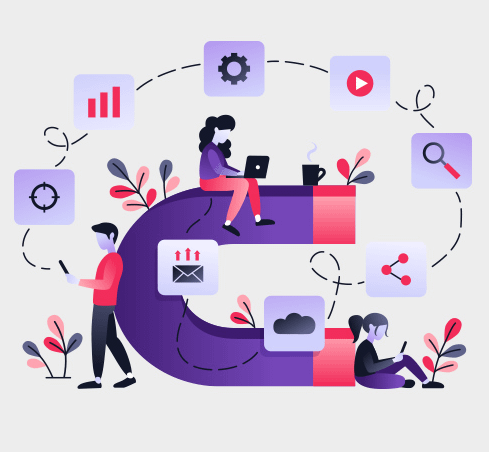Introduction
The full customer acquisition process involves the interaction of your sales funnel, your digital marketing strategies, and the customer lifecycle in more complex ways. The entire process also begins earlier (in terms of brand awareness or peer referrals) and extends long after (continued engagement and cultivation) the classic funnel conception of sales.
The “customer lifecycle” refers to how your customers experience your business before, during, and after making a purchase. Here’s roughly how they all fit together:
Let’s walk through the steps in this diagram:
- In Stage 1 of the customer lifecycle, a new prospect visits your website for the first time. Your social media, email, or other digital advertising efforts might have drawn them to your store, or a referral from a peer made them curious about what you offer. Your website’s educational content, including industry research, blog posts, and other articles help to raise their awareness of your products or services.
- In Stage 2, the prospect has expressed their interest. Your website’s content, special deals in your store, or other lead capture techniques secured the prospect’s contact information. More informational content, product comparisons, and case studies are useful types of digital marketing materials for both capturing leads and keeping prospects interested.
- In Stage 3, your prospective customer has been ‘activated’. This means you’re directly engaging them with your products or services. For retail eCommerce, this might mean they’ve visited your product pages and begun putting items into their shopping cart. For online B2B companies, this stage usually involves demonstrations and proposals.
- In Stage 4, you successfully convert your prospect into a customer. They’ve paid for your services or products, and you’ve started processing their order. More online content like FAQs and blog posts are can keep eCommerce customers engaged at this point, and this is when SaaS companies should begin the training and support process.
- In Stage 5, your active customers use your product or services. For B2C eCommerce, this stage involves asking customers for reviews and for continued engagement with your digital content. For B2B, this stage might involve fully onboarding new customers, setting up the product, and beginning training via manuals, workshops, and personal customer service.
- In Stage 6, your loyal customers renew their support of your business. They might either purchase from you again or upgrade their existing purchases. It’s important to keep track of digital engagement metrics, renewal rates, and churn rates in order to focus your efforts more efficiently. Try to track the amount of referral business that you receive whenever possible, as well.
Of course, this process will vary slightly depending on the nuances of your business model and your online audience, but the main idea is that the sales process, digital marketing, and the customer lifecycle are all connected. They should work together to provide a positive experience at every step.
Generating conversions is an essential part of the customer acquisition process, but it differs from the classic sales funnel structure in an important way. Your customer acquisition strategy should take the pre-sale and post-sale experience of your customers into account, not just the sale itself. Fully understanding the acquisition process and building a comprehensive strategy around it works for eCommerce companies of all sizes because it can boost both conversions and retention.

